Abstract
Clostridium difficile causes pseudomembranous colitis in humans. The enterotoxin (i.e., toxin A) from this organism is believed to be responsible for the initial intestinal pathology associated with this disease. Previous work shows that this toxin binds to carbohydrates that contain Gal alpha 1-3Gal beta 1-4GlcNAc. However, this carbohydrate is not present on normal human cells. Therefore, this study was undertaken to identify potential receptors for toxin A that do exist on human intestinal epithelium. Using enzyme-linked immunosorbent assay, affinity chromatography, and altered migration in an electric field, we assayed the binding of toxin A to purified carbohydrates and glycoproteins. We found that toxin A bound to the carbohydrate antigens designated I, X, and Y. Each of these carbohydrates exist on the intestinal epithelium of humans.
Full text
PDF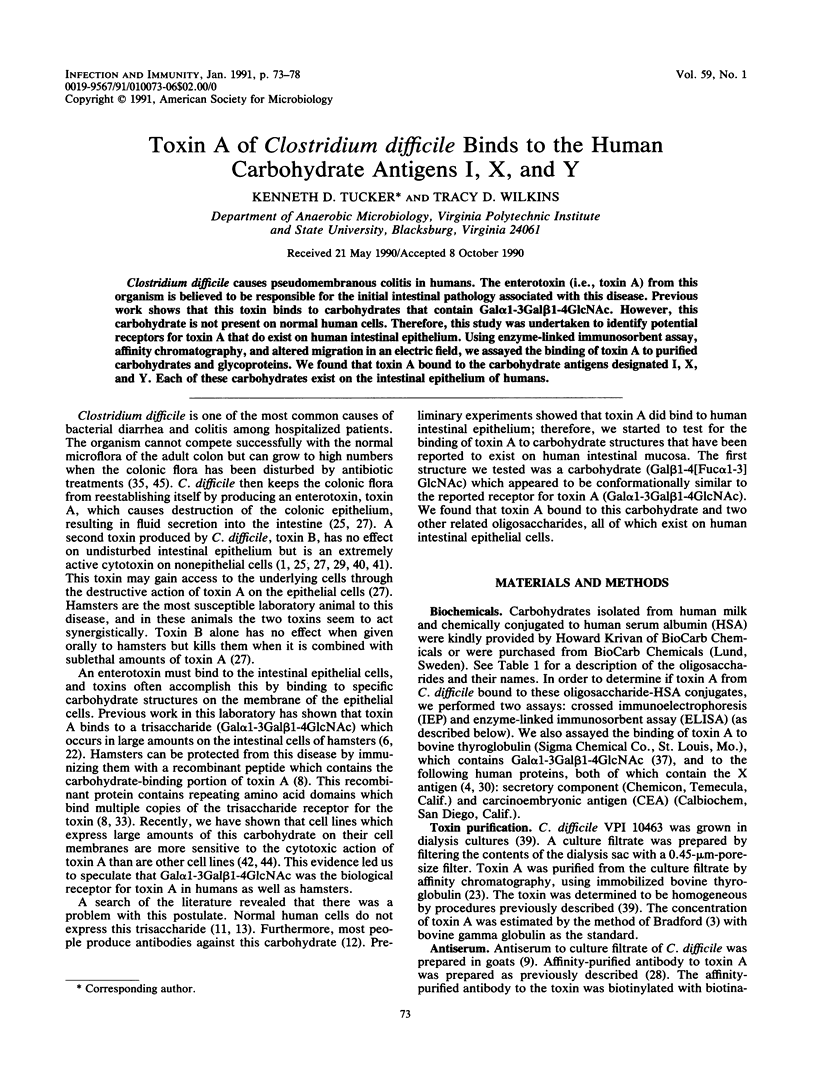
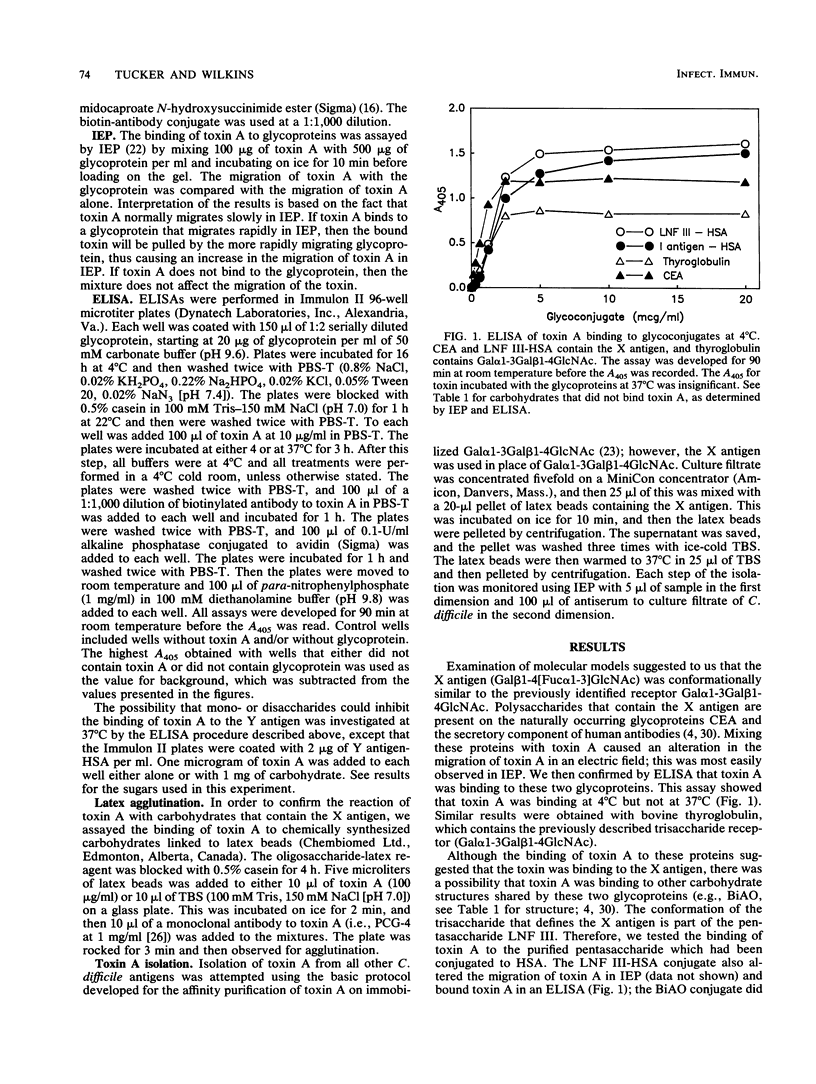
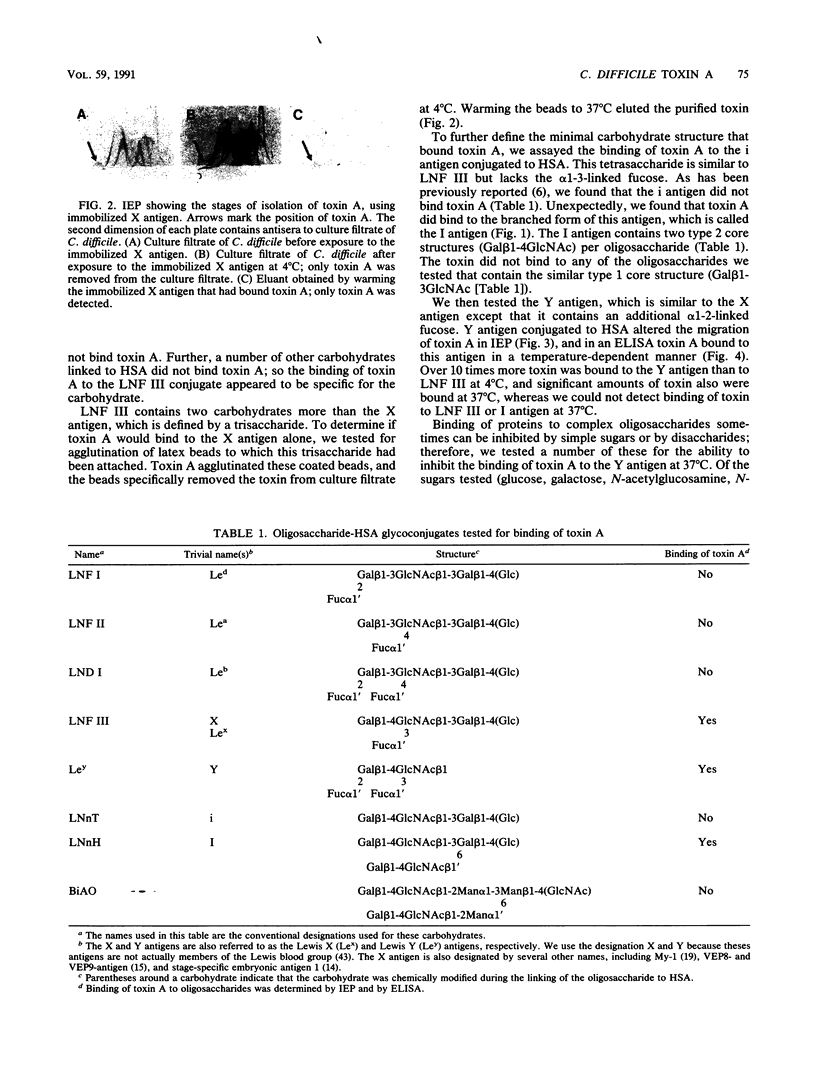
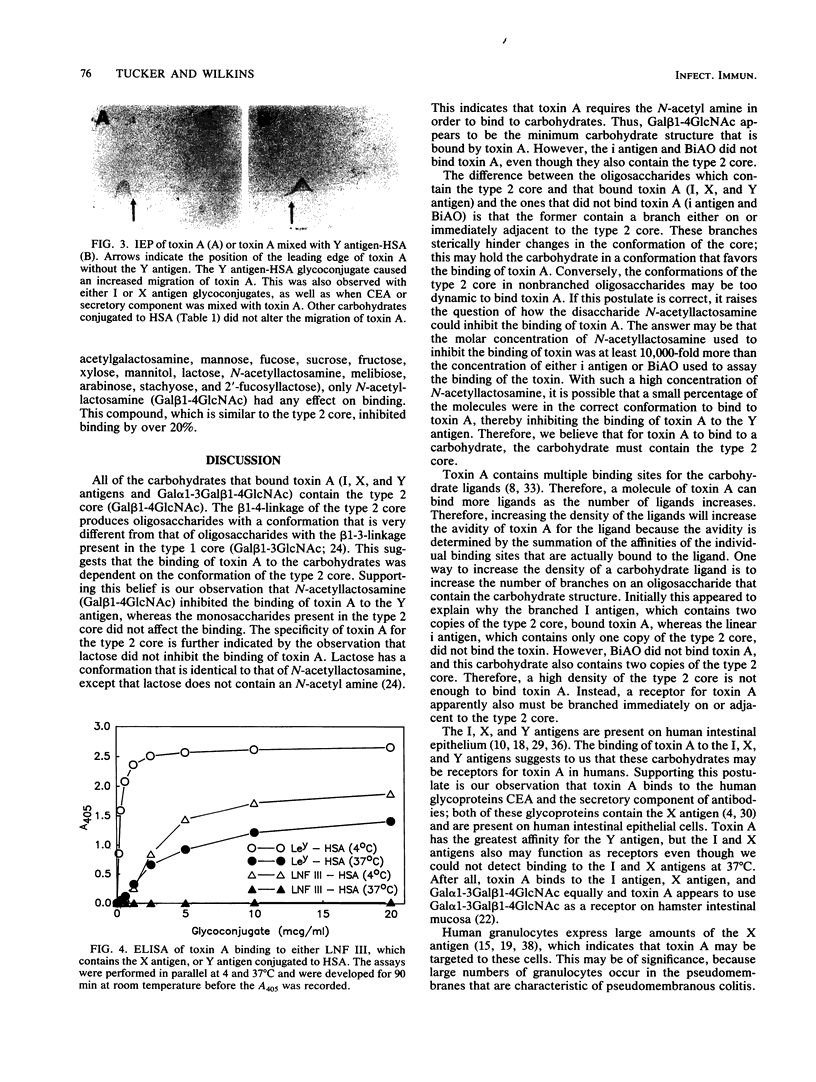
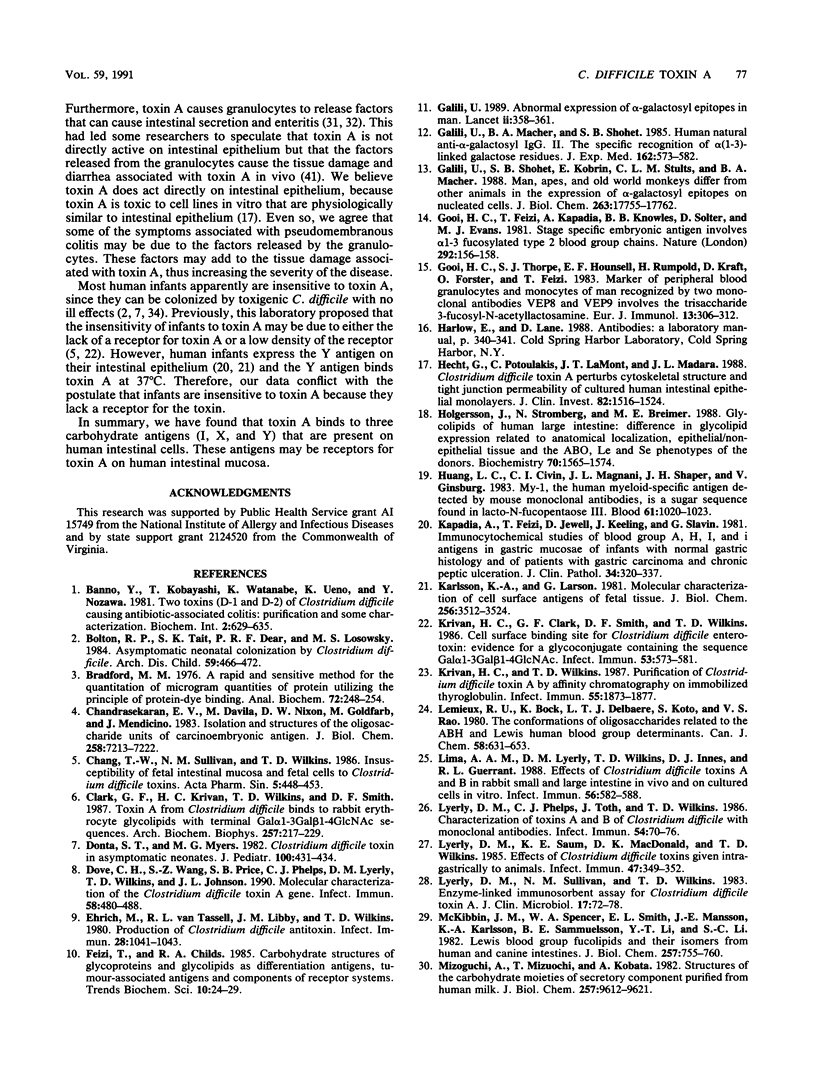
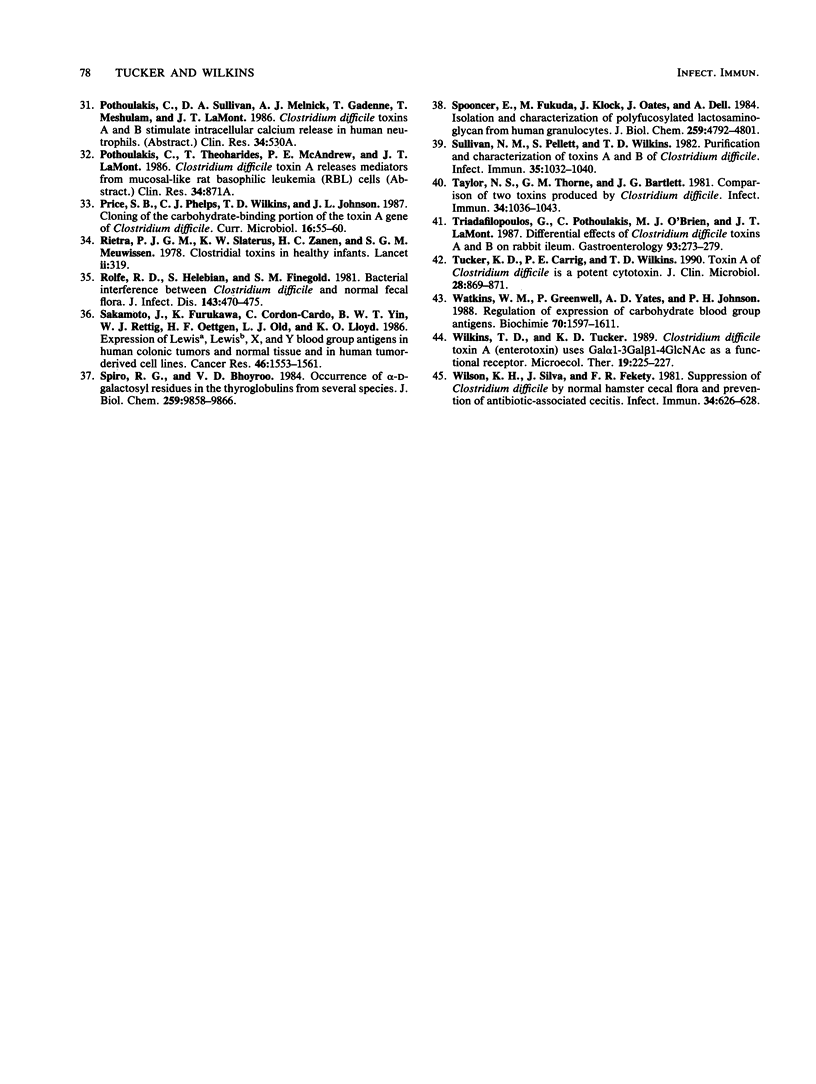
Images in this article
Selected References
These references are in PubMed. This may not be the complete list of references from this article.
- Bolton R. P., Tait S. K., Dear P. R., Losowsky M. S. Asymptomatic neonatal colonisation by Clostridium difficile. Arch Dis Child. 1984 May;59(5):466–472. doi: 10.1136/adc.59.5.466. [DOI] [PMC free article] [PubMed] [Google Scholar]
- Bradford M. M. A rapid and sensitive method for the quantitation of microgram quantities of protein utilizing the principle of protein-dye binding. Anal Biochem. 1976 May 7;72:248–254. doi: 10.1016/0003-2697(76)90527-3. [DOI] [PubMed] [Google Scholar]
- Chandrasekaran E. V., Davila M., Nixon D. W., Goldfarb M., Mendicino J. Isolation and structures of the oligosaccharide units of carcinoembryonic antigen. J Biol Chem. 1983 Jun 10;258(11):7213–7222. [PubMed] [Google Scholar]
- Chang T. W., Sullivan N. M., Wilkins T. D. Insusceptibility of fetal intestinal mucosa and fetal cells to Clostridium difficile toxins. Zhongguo Yao Li Xue Bao. 1986 Sep;7(5):448–453. [PubMed] [Google Scholar]
- Clark G. F., Krivan H. C., Wilkins T. D., Smith D. F. Toxin A from Clostridium difficile binds to rabbit erythrocyte glycolipids with terminal Gal alpha 1-3Gal beta 1-4GlcNAc sequences. Arch Biochem Biophys. 1987 Aug 15;257(1):217–229. doi: 10.1016/0003-9861(87)90561-3. [DOI] [PubMed] [Google Scholar]
- Donta S. T., Myers M. G. Clostridium difficile toxin in asymptomatic neonates. J Pediatr. 1982 Mar;100(3):431–434. doi: 10.1016/s0022-3476(82)80454-x. [DOI] [PubMed] [Google Scholar]
- Dove C. H., Wang S. Z., Price S. B., Phelps C. J., Lyerly D. M., Wilkins T. D., Johnson J. L. Molecular characterization of the Clostridium difficile toxin A gene. Infect Immun. 1990 Feb;58(2):480–488. doi: 10.1128/iai.58.2.480-488.1990. [DOI] [PMC free article] [PubMed] [Google Scholar]
- Ehrich M., Van Tassell R. L., Libby J. M., Wilkins T. D. Production of Clostridium difficile antitoxin. Infect Immun. 1980 Jun;28(3):1041–1043. doi: 10.1128/iai.28.3.1041-1043.1980. [DOI] [PMC free article] [PubMed] [Google Scholar]
- Galili U. Abnormal expression of alpha-galactosyl epitopes in man. A trigger for autoimmune processes? Lancet. 1989 Aug 12;2(8659):358–361. doi: 10.1016/s0140-6736(89)90539-4. [DOI] [PubMed] [Google Scholar]
- Galili U., Macher B. A., Buehler J., Shohet S. B. Human natural anti-alpha-galactosyl IgG. II. The specific recognition of alpha (1----3)-linked galactose residues. J Exp Med. 1985 Aug 1;162(2):573–582. doi: 10.1084/jem.162.2.573. [DOI] [PMC free article] [PubMed] [Google Scholar]
- Galili U., Shohet S. B., Kobrin E., Stults C. L., Macher B. A. Man, apes, and Old World monkeys differ from other mammals in the expression of alpha-galactosyl epitopes on nucleated cells. J Biol Chem. 1988 Nov 25;263(33):17755–17762. [PubMed] [Google Scholar]
- Gooi H. C., Feizi T., Kapadia A., Knowles B. B., Solter D., Evans M. J. Stage-specific embryonic antigen involves alpha 1 goes to 3 fucosylated type 2 blood group chains. Nature. 1981 Jul 9;292(5819):156–158. doi: 10.1038/292156a0. [DOI] [PubMed] [Google Scholar]
- Gooi H. C., Thorpe S. J., Hounsell E. F., Rumpold H., Kraft D., Förster O., Feizi T. Marker of peripheral blood granulocytes and monocytes of man recognized by two monoclonal antibodies VEP8 and VEP9 involves the trisaccharide 3-fucosyl-N-acetyllactosamine. Eur J Immunol. 1983 Apr;13(4):306–312. doi: 10.1002/eji.1830130407. [DOI] [PubMed] [Google Scholar]
- Hecht G., Pothoulakis C., LaMont J. T., Madara J. L. Clostridium difficile toxin A perturbs cytoskeletal structure and tight junction permeability of cultured human intestinal epithelial monolayers. J Clin Invest. 1988 Nov;82(5):1516–1524. doi: 10.1172/JCI113760. [DOI] [PMC free article] [PubMed] [Google Scholar]
- Holgersson J., Strömberg N., Breimer M. E. Glycolipids of human large intestine: difference in glycolipid expression related to anatomical localization, epithelial/non-epithelial tissue and the ABO, Le and Se phenotypes of the donors. Biochimie. 1988 Nov;70(11):1565–1574. doi: 10.1016/0300-9084(88)90292-1. [DOI] [PubMed] [Google Scholar]
- Huang L. C., Civin C. I., Magnani J. L., Shaper J. H., Ginsburg V. My-1, the human myeloid-specific antigen detected by mouse monoclonal antibodies, is a sugar sequence found in lacto-N-fucopentaose III. Blood. 1983 May;61(5):1020–1023. [PubMed] [Google Scholar]
- Kapadia A., Feizi T., Jewell D., Keeling J., Slavin G. Immunocytochemical studies of blood group A, H, I, and i antigens in gastric mucosae of infants with normal gastric histology and of patients with gastric carcinoma and chronic benign peptic ulceration. J Clin Pathol. 1981 Mar;34(3):320–337. doi: 10.1136/jcp.34.3.320. [DOI] [PMC free article] [PubMed] [Google Scholar]
- Karlsson K. A., Larson G. Molecular characterization of cell surface antigens of fetal tissue. Detailed analysis of glycosphingolipids of meconium of a human O Le(a--b+) secretor. J Biol Chem. 1981 Apr 10;256(7):3512–3524. [PubMed] [Google Scholar]
- Krivan H. C., Clark G. F., Smith D. F., Wilkins T. D. Cell surface binding site for Clostridium difficile enterotoxin: evidence for a glycoconjugate containing the sequence Gal alpha 1-3Gal beta 1-4GlcNAc. Infect Immun. 1986 Sep;53(3):573–581. doi: 10.1128/iai.53.3.573-581.1986. [DOI] [PMC free article] [PubMed] [Google Scholar]
- Krivan H. C., Wilkins T. D. Purification of Clostridium difficile toxin A by affinity chromatography on immobilized thyroglobulin. Infect Immun. 1987 Aug;55(8):1873–1877. doi: 10.1128/iai.55.8.1873-1877.1987. [DOI] [PMC free article] [PubMed] [Google Scholar]
- Lima A. A., Lyerly D. M., Wilkins T. D., Innes D. J., Guerrant R. L. Effects of Clostridium difficile toxins A and B in rabbit small and large intestine in vivo and on cultured cells in vitro. Infect Immun. 1988 Mar;56(3):582–588. doi: 10.1128/iai.56.3.582-588.1988. [DOI] [PMC free article] [PubMed] [Google Scholar]
- Lyerly D. M., Phelps C. J., Toth J., Wilkins T. D. Characterization of toxins A and B of Clostridium difficile with monoclonal antibodies. Infect Immun. 1986 Oct;54(1):70–76. doi: 10.1128/iai.54.1.70-76.1986. [DOI] [PMC free article] [PubMed] [Google Scholar]
- Lyerly D. M., Saum K. E., MacDonald D. K., Wilkins T. D. Effects of Clostridium difficile toxins given intragastrically to animals. Infect Immun. 1985 Feb;47(2):349–352. doi: 10.1128/iai.47.2.349-352.1985. [DOI] [PMC free article] [PubMed] [Google Scholar]
- Lyerly D. M., Sullivan N. M., Wilkins T. D. Enzyme-linked immunosorbent assay for Clostridium difficile toxin A. J Clin Microbiol. 1983 Jan;17(1):72–78. doi: 10.1128/jcm.17.1.72-78.1983. [DOI] [PMC free article] [PubMed] [Google Scholar]
- McKibbin J. M., Spencer W. A., Smith E. L., Mansson J. E., Karlsson K. A., Samuelsson B. E., Li Y. T., Li S. C. Lewis blood group fucolipids and their isomers from human and canine intestine. J Biol Chem. 1982 Jan 25;257(2):755–760. [PubMed] [Google Scholar]
- Mizoguchi A., Mizuochi T., Kobata A. Structures of the carbohydrate moieties of secretory component purified from human milk. J Biol Chem. 1982 Aug 25;257(16):9612–9621. [PubMed] [Google Scholar]
- Rietra P. J., Slaterus K. W., Zanen H. C., Meuwissen S. G. Clostridial toxin in faeces of healthy infants. Lancet. 1978 Aug 5;2(8084):319–319. doi: 10.1016/s0140-6736(78)91723-3. [DOI] [PubMed] [Google Scholar]
- Rolfe R. D., Helebian S., Finegold S. M. Bacterial interference between Clostridium difficile and normal fecal flora. J Infect Dis. 1981 Mar;143(3):470–475. doi: 10.1093/infdis/143.3.470. [DOI] [PubMed] [Google Scholar]
- Sakamoto J., Furukawa K., Cordon-Cardo C., Yin B. W., Rettig W. J., Oettgen H. F., Old L. J., Lloyd K. O. Expression of Lewisa, Lewisb, X, and Y blood group antigens in human colonic tumors and normal tissue and in human tumor-derived cell lines. Cancer Res. 1986 Mar;46(3):1553–1561. [PubMed] [Google Scholar]
- Spiro R. G., Bhoyroo V. D. Occurrence of alpha-D-galactosyl residues in the thyroglobulins from several species. Localization in the saccharide chains of the complex carbohydrate units. J Biol Chem. 1984 Aug 10;259(15):9858–9866. [PubMed] [Google Scholar]
- Spooncer E., Fukuda M., Klock J. C., Oates J. E., Dell A. Isolation and characterization of polyfucosylated lactosaminoglycan from human granulocytes. J Biol Chem. 1984 Apr 25;259(8):4792–4801. [PubMed] [Google Scholar]
- Sullivan N. M., Pellett S., Wilkins T. D. Purification and characterization of toxins A and B of Clostridium difficile. Infect Immun. 1982 Mar;35(3):1032–1040. doi: 10.1128/iai.35.3.1032-1040.1982. [DOI] [PMC free article] [PubMed] [Google Scholar]
- Taylor N. S., Thorne G. M., Bartlett J. G. Comparison of two toxins produced by Clostridium difficile. Infect Immun. 1981 Dec;34(3):1036–1043. doi: 10.1128/iai.34.3.1036-1043.1981. [DOI] [PMC free article] [PubMed] [Google Scholar]
- Triadafilopoulos G., Pothoulakis C., O'Brien M. J., LaMont J. T. Differential effects of Clostridium difficile toxins A and B on rabbit ileum. Gastroenterology. 1987 Aug;93(2):273–279. doi: 10.1016/0016-5085(87)91014-6. [DOI] [PubMed] [Google Scholar]
- Tucker K. D., Carrig P. E., Wilkins T. D. Toxin A of Clostridium difficile is a potent cytotoxin. J Clin Microbiol. 1990 May;28(5):869–871. doi: 10.1128/jcm.28.5.869-871.1990. [DOI] [PMC free article] [PubMed] [Google Scholar]
- Watkins W. M., Greenwell P., Yates A. D., Johnson P. H. Regulation of expression of carbohydrate blood group antigens. Biochimie. 1988 Nov;70(11):1597–1611. doi: 10.1016/0300-9084(88)90295-7. [DOI] [PubMed] [Google Scholar]
- Wilson K. H., Silva J., Fekety F. R. Suppression of Clostridium difficile by normal hamster cecal flora and prevention of antibiotic-associated cecitis. Infect Immun. 1981 Nov;34(2):626–628. doi: 10.1128/iai.34.2.626-628.1981. [DOI] [PMC free article] [PubMed] [Google Scholar]




